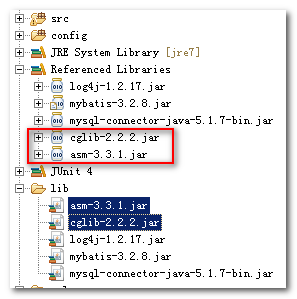13.1、自定义结果集介绍
自定义结果集,可以给复杂的对象使用。也就是对象内又嵌套一个对象。或者一个集合。
在这种情况下。前面学过的知识点,已经无法直接获取出对象内对象的信息。
这个时候就需要使用resultMap自定义结果集来返回需要的数据。
13.2、创建一对一数据库表
## 一对一数据表
## 创建锁表
create table t_lock(
`id` int primary key auto_increment,
`name` varchar(50)
);
## 创建钥匙表
create table t_key(
`id` int primary key auto_increment,
`name` varchar(50),
`lock_id` int ,
foreign key(`lock_id`) references t_lock(`id`)
);
## 插入初始化数据
insert into t_lock(`name`) values('阿里巴巴');
insert into t_lock(`name`) values('华为');
insert into t_lock(`name`) values('联想');
insert into t_key(`name`,`lock_id`) values('马云',1);
insert into t_key(`name`,`lock_id`) values('任正非',2);
insert into t_key(`name`,`lock_id`) values('柳传志',3);
13.3、创建实体对象
钥匙对象
public class Key {
private int id;
private String name;
private Lock lock;
锁对象
public class Lock {
private int id;
private String name;
13.4、一对一的使用示例
13.4.1、创建 KeyMapper 接口
public interface KeyMapper {
public Key queryKeyForSimple(int id);
}
13.4.2、级联属性的映射配置
<!--
resultMap标签专门用来定义自定义的结果集数据。
type属性设置返回的数据类型
id属性定义一个唯一标识
-->
<resultMap type="com.bean.Key" id="queryKeyForSimple_resultMap">
<!-- id定义主键列 -->
<id column="id" property="id"/>
<!-- result 定义一个列和属性的映射 -->
<result column="name" property="name"/>
<!-- lock.id 和 lock.name 叫级联属性映射 -->
<result column="lock_id" property="lock.id"/>
<result column="lock_name" property="lock.name"/>
</resultMap>
<!--
select 标签用于定义一个select语句
id属性设置一个statement标识
parameterType设置参数的类型
resultMap 设置返回的结果类型
-->
<select id="queryKeyForSimple" parameterType="int" resultMap="queryKeyForSimple_resultMap">
select t_key.*,t_lock.name lock_name
from
t_key left join t_lock
on
t_key.lock_id = t_lock.id
where
t_key.id = #{id}
</select>
13.4.3、<association /> 嵌套结果集映射配置
<association /> 标签可以给返回结果中对象的属性是子对象的情况,进行映射。
比如:Key对象中有一个子对象Lock。就可以使用<association /> 来进行映射返回
<!--
resultMap标签专门用来定义自定义的结果集数据。
type属性设置返回的数据类型
id属性定义一个唯一标识
-->
<resultMap type="com.bean.Key" id="queryKeyForSimple_resultMap_association">
<!-- id定义主键列 -->
<id column="id" property="id"/>
<!-- result 定义一个列和属性的映射 -->
<result column="name" property="name"/>
<!--
association 标签可以给一个子对象定义列的映射。
property 属性设置 子对象的属性名 lock
javaType 属性设置子对象的全类名
-->
<association property="lock" javaType="com.bean.Lock">
<!-- id 属性定义主键 -->
<id column="lock_id" property="id"/>
<!-- result 标签定义列和对象属性的映射 -->
<result column="lock_name" property="name"/>
</association>
</resultMap>
13.4.4、KeyMapper的测试代码
@Test
public void testQueryKeyForSimple() {
SqlSession session = sqlSessionFactory.openSession();
try {
KeyMapper keyMapper = session.getMapper( KeyMapper.class );
System.out.println( keyMapper.queryKeyForSimple(1) );
} finally {
session.close();
}
}
运行的结果:

13.4.5、 定义分步查询
添加一个 LockMapper 接口
public interface LockMapper {
public Lock queryLockById(int lockId);
}
添加 LockMapper 接口对应的配置文件
<?xml version="1.0" encoding="UTF-8" ?>
<!DOCTYPE mapper
PUBLIC "-//mybatis.org//DTD Mapper 3.0//EN"
"http://mybatis.org/dtd/mybatis-3-mapper.dtd">
<mapper namespace="com.dao.LockMapper">
<!-- 定义一个根据id查询锁的select -->
<select id="queryLockById" parameterType="int" resultType="com.bean.Lock">
select id , name from t_lock where id = #{value}
</select>
</mapper>
在KeyMapper接口中,添加另一个方法分步查询:
public interface KeyMapper {
public Key queryKeyForSimple(int id);
public Key queryKeyByTwoStep(int id);
}
修改KeyMapper中的配置
<!-- resultMap 标签定义复杂对象的结果集数据 -->
<resultMap type="com.bean.Key" id="queryKeyByTwoStep_resultMap">
<id column="id" property="id"/>
<result column="name" property="name"/>
<!--
association标签定义一个子对象的集合集
property 属性映射子对象的名称
select 属性定义执行的查询语句
也就是说。property指定的lock子对象,是通过执行。select标识的查询语句返回
column 属性定义需要传递给select语句的参数
-->
<association property="lock" select="com.dao.LockMapper.queryLockById" column="lock_id" />
</resultMap>
<!--
定义分步查询的select
-->
<select id="queryKeyByTwoStep" parameterType="int" resultMap="queryKeyByTwoStep_resultMap">
select id,name,lock_id from t_key where id = #{value}
</select>
分步查询的测试代码:
@Test
public void testQueryKeyByTwoStep() {
SqlSession session = sqlSessionFactory.openSession();
try {
KeyMapper keyMapper = session.getMapper( KeyMapper.class );
System.out.println( keyMapper.queryKeyByTwoStep(1) );
} finally {
session.close();
}
}
运行结果:

13.5、延迟加载
延迟加载在一定程序上可以减少很多没有必要的查询。给数据库服务器提升性能上的优化。
要启用延迟加载,需要在mybatis-config.xml配置文件中,添加如下两个全局的settings配置。
<!-- 打开延迟加载的开关 -->
<setting name="lazyLoadingEnabled" value="true" />
<!-- 将积极加载改为消极加载 按需加载 -->
<setting name="aggressiveLazyLoading" value="false"/>
懒加载还需要同时引入两个jar包
修改mybatis-config.xml配置文件,添加全局的设置
<!-- 配置全局mybatis的配置 -->
<settings>
<!-- 启用驼峰标识 -->
<setting name="mapUnderscoreToCamelCase" value="true" />
<!-- 打开延迟加载的开关 -->
<setting name="lazyLoadingEnabled" value="true" />
<!-- 将积极加载改为消息加载即按需加载 -->
<setting name="aggressiveLazyLoading" value="false" />
</settings>
添加类库到工程项目中

13.6、多对一、一对多的使用示例
13.6.1、创建一对多数据库
## 一对多数据表
## 创建班级表
create table t_clazz(
`id` int primary key auto_increment,
`name` varchar(50)
);
## 插入班级信息
insert into t_clazz(`name`) values('javaEE20170228');
insert into t_clazz(`name`) values('javaEE20170325');
insert into t_clazz(`name`) values('javaEE20170420');
insert into t_clazz(`name`) values('javaEE20170515');
## 创建学生表
create table t_student(
`id` int primary key auto_increment,
`name` varchar(50),
`clazz_id` int,
foreign key(`clazz_id`) references t_clazz(`id`)
);
## 插入班级信息
insert into t_student(`name`,`clazz_id`) values('stu0228_1',1);
insert into t_student(`name`,`clazz_id`) values('stu0228_2',1);
insert into t_student(`name`,`clazz_id`) values('stu0228_3',1);
insert into t_student(`name`,`clazz_id`) values('stu0325_1',2);
insert into t_student(`name`,`clazz_id`) values('stu0325_2',2);
insert into t_student(`name`,`clazz_id`) values('stu0420_1',3);
13.6.2、<collection/> 一对多,立即加载关联查询
创建实体对象
班级对象
public class Clazz {
private int id;
private String name;
private List<Student> stus;
学生对象
public class Student {
private int id;
private String name;
创建ClazzMapper接口类:
public interface ClazzMapper {
public Clazz queryClazzByIdForSimple(int id);
}
编写ClazzMapper.xml配置文件
<mapper namespace="com.dao.ClazzMapper">
<!--
resultMap可以定义一个自定义的结果集返回
-->
<resultMap type="com.bean.Clazz" id="queryClazzByIdForSimple_resultMap">
<id column="id" property="id"/>
<result column="name" property="name"/>
<!--
collection定义一个子集合对象返回
-->
<collection property="stus" ofType="com.bean.Student">
<id column="student_id" property="id"/>
<result column="student_name" property="name"/>
</collection>
</resultMap>
<!-- 定义一个立即加载的查询Clazz对象 -->
<select id="queryClazzByIdForSimple" parameterType="int" resultMap="queryClazzByIdForSimple_resultMap">
select t_clazz.* , t_student.id student_id,t_student.name student_name
from
t_clazz left join t_student
on
t_clazz.id = t_student.clazz_id
where
t_clazz.id = #{id}
</select>
</mapper>
测试代码:
@Test
public void testQueryClazzByIdForSimple() {
SqlSession session = sqlSessionFactory.openSession();
try {
ClazzMapper clazzMapper = session.getMapper( ClazzMapper.class );
System.out.println( clazzMapper.queryClazzByIdForSimple(1) );
} finally {
session.close();
}
}
运行效果:

13.6.3、一对多,赖加载
在ClazzMapper接口中添加一个分步查询延迟加载的方法
public interface ClazzMapper {
public Clazz queryClazzByIdForSimple(int id);
public Clazz queryClazzByIdForLazy(int id);
}
创建一个StudentMapper接口
public interface StudentMapper {
public List<Student> queryStudentsByClazzId(int clazzId);
}
创建StudentMapper.xml配置文件
<!-- 根据班级id查询学生信息 -->
<select id="queryStudentsByClazzId" parameterType="int" resultType="com.bean.Student">
select id,name from t_student where clazz_id = #{value}
</select>
修改ClazzMapper.xml配置文件内容:
<!-- 创建一个自定义集合集 -->
<resultMap type="com.bean.Clazz" id="queryClazzByIdForLazy_resultMap">
<id column="id" property="id"/>
<result column="name" property="name"/>
<collection property="stus" ofType="com.bean.Student"
select="com.dao.StudentMapper.queryStudentsByClazzId" column="id" />
</resultMap>
<!-- 创建一个懒加载Clazz对象的查询 -->
<select id="queryClazzByIdForLazy" parameterType="int" resultMap="queryClazzByIdForLazy_resultMap">
select id,name from t_clazz where id = #{value}
</select>
修改log4j日记配置文件如下:
# Global logging configuration
log4j.rootLogger=DEBUG, stdout
# MyBatis logging configuration...
#log4j.logger.org.mybatis.example.BlogMapper=TRACE
# Console output...
log4j.appender.stdout=org.apache.log4j.ConsoleAppender
log4j.appender.stdout.layout=org.apache.log4j.PatternLayout
log4j.appender.stdout.layout.ConversionPattern=%5p [%t %d{HH:mm:ss}] - %m%n
上面日记中标黄的部分,是给日记添加当前时间的输出
测试延迟加载的代码
@Test
public void testQueryClazzByIdForLazy() {
SqlSession session = sqlSessionFactory.openSession();
try {
ClazzMapper clazzMapper = session.getMapper( ClazzMapper.class );
Clazz clazz = clazzMapper.queryClazzByIdForLazy( 1 );
System.out.println(clazz.getName());
try {
//暂停一会儿
Thread.sleep(5000);
} catch (Exception e) {
e.printStackTrace();
}
System.out.println(clazz.getStus());
} finally {
session.close();
}
}
运行效果:

13.6.4、双向关联
修改班级对象
public class Clazz {
private int id;
private String name;
private List<Student> stus;
修改学生对象
public class Student {
private int id;
private String name;
private Clazz clazz;
修改StudentMapper配置文件
<resultMap type="com.bean.Student" id="queryStudentsByClazzId_resultMap">
<id column="id" property="id"/>
<result column="name" property="name"/>
<association property="clazz" javaType="com.atguigu.bean.Clazz"
select="com.dao.ClazzMapper.queryClazzByIdForLazy" column="clazz_id"></association>
</resultMap>
<!-- 根据班级id查询学生信息 -->
<select id="queryStudentsByClazzId" parameterType="int"
resultMap="queryStudentsByClazzId_resultMap">
select id,name,clazz_id from t_student where clazz_id = #{value}
</select>
注意:双向关联,要小心进入死循环,
1、防止死循环就是不要调用toString方法
2、最后一次查询返回resultType.
修改测试的代码如下:
@Test
public void testQueryClazzByIdForLazy() {
SqlSession session = sqlSessionFactory.openSession();
try {
ClazzMapper clazzMapper = session.getMapper( ClazzMapper.class );
Clazz clazz = clazzMapper.queryClazzByIdForLazy( 1 );
System.out.println(clazz.getName());
try {
//暂停一会儿
Thread.sleep(3000);
} catch (Exception e) {
e.printStackTrace();
}
System.out.println(clazz.getStus().get(0).getName());
System.out.println(clazz.getStus().get(0).getClazz().getName());
} finally {
session.close();
}
}